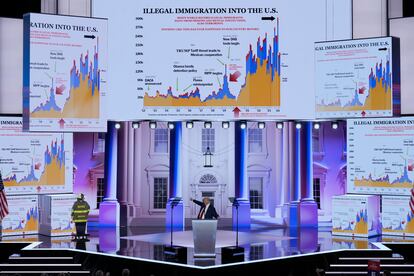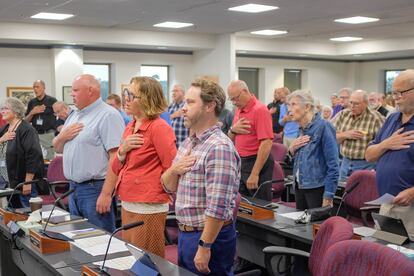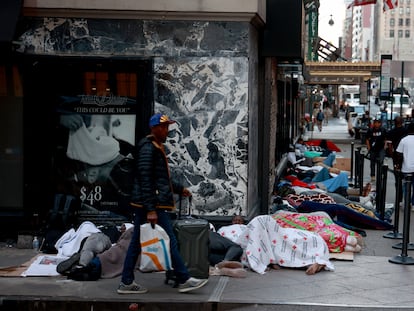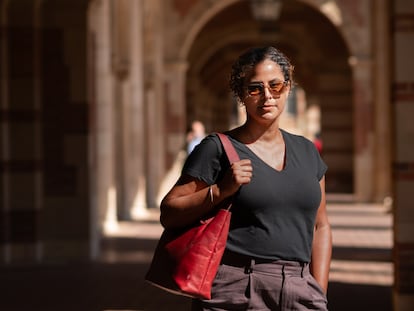Lies about immigration beyond the border: A journey through the crucial state of Wisconsin
In the Badger State, one of the seven territories that could decide the outcome of next Tuesday’s elections, disinformation about immigrants runs rampant

A few weeks before the election, I traveled to Wisconsin, the crucial battleground state some 1,500 miles away from what’s been described as a place where evil runs rampant, a place which also happens to be my home. El Paso felt very present in the Badger State — at least it did as the distorted, over-hyped version of an “open border” narrative that plays incessantly on locally broadcast political ads. I came to Wisconsin in part to understand how disinformation about the borderlands and immigration travels wide and far.
The televised portrayal of my homeland was so downright scary that it kept me awake into the wee hours. But the video loop of rapists, murderers, and fentanyl — monsters all — sneaking across from Mexico and threatening the United States day and night, served as a reminder of the daunting task ahead. I’m the executive editor and a field correspondent for Puente News Collaborative, a bilingual nonprofit online newsroom based in El Paso. My veteran colleagues — Eduardo Garcia and Dudley Althaus — and I face the uphill challenge of countering the ether-world’s border narrative by pushing back with facts on the ground, from Tamaulipas-Brownsville to Tijuana-San Diego.
The task seems especially urgent at a time when many Americans fret about a supposed enemy within. These Americans want it both ways — using the cheap labor that immigrants provide while loathing the unavoidable change that the newcomers bring.
They want immigrants, both legal and undocumented, to harvest their crops, staff their restaurants, clean their hotels, offices, babysit their children, take care of the elderly, trim their yards, clean their pools and install their new roofs. They also want to demonize the newcomers who often gird local economies. And they take particular aim at Mexico, the country that’s now the United States’ leading trading partner. After 30 years of free trade within North America, industrial supply chains reach deep into the heartlands of Mexico, Canada and the United States, especially in the automotive industry. Mexico is a premier customer of U.S. grain and natural gas. About $800 billion in bilateral trade now crosses the U.S.-Mexico border annually, making each country’s economies deeply dependent on the other.

For nearly a week, Dudley and I traveled throughout Wisconsin, along the southwestern shore of Lake Michigan and down two-lane roads that cut into the state’s farmlands. We witnessed newcomers remaking century-old neighborhoods and small towns that were once home to immigrants from Germany, Poland, Serbia, Ireland, and elsewhere. At times, it proved an uneasy, testy rebirth.
As I reported on Wisconsinites’ perceptions of the border, I also pushed back on the disinformation I saw and heard. When I said I was from El Paso, the Ellis Island of the Southwest, some talked as though they knew better than me where I’m from, based on what they saw streaming on their large and tiny screens. A few seemed surprised that I was even alive, given all the campaign ads portraying a dangerous, chaotic border populated by bloodthirsty criminals.
I reminded Midwesterners that I hail from one of the safest regions anywhere in the United States. As I explained to a woman in Whitewater, a quaint university town, the greatest danger I’ve witnessed was by a young white male from North Texas who drove 10 hours to El Paso with an assault rifle to “kill Mexicans” and “stop the Hispanic invasion of Texas.” The white man obviously doesn’t know the history of the Southwest.
That guy killed 23 people on August 3rd, 2019, mostly Mexicans, and injured dozens more at a Walmart Supercenter. It was a Saturday and many of the customers were buying back-to-school supplies. It was the first weekend of the month and many elderlies were there to retrieve their Social Security funds. The store is known as the “Mexican Walmart,” because so many Mexicans cross the nearby international bridge to shop there. My own parents shopped there too.
Maybe there was a need for a wall, I thought. But the place to build it was on the eastern, western and northern side of El Paso to keep evil away from heartland Americans who fear the country’s changing demographics.

El Paso in fact offers a window on changing U.S. economic and cultural forces. The woman and I agreed that our nation’s future workforce is tied to the newcomers, legal or not. We traded ideas on the various products crisscrossing the border — everything from milk and grain to tractors to electronics. We swapped stories about our favorite foods, whether Wisconsin bratwurst or green sauce enchiladas. We bantered about our favorite tequila and beer.
I returned to the border from Wisconsin with a tinge of hope. One recent sunset, I stepped outside my home office and stared at the bone-gray mountainside of west El Paso and pondered the Rio Grande winding to the Southwest, the giant statue of Christ the King up the slope to the north. This is the space where our two nations’ languages, cultures and economies blur on the arid corner where Texas, New Mexico and the Mexican state of Chihuahua converge.
At times, we remain uneasy neighbors, as evidenced by the rust iron fence that defines the borderline here. But most of us overcome the friction through tolerance and a respect for one another. In these turbulent times, I conclude, my homeland has a lot to teach the heartland.

Tu suscripción se está usando en otro dispositivo
¿Quieres añadir otro usuario a tu suscripción?
Si continúas leyendo en este dispositivo, no se podrá leer en el otro.
FlechaTu suscripción se está usando en otro dispositivo y solo puedes acceder a EL PAÍS desde un dispositivo a la vez.
Si quieres compartir tu cuenta, cambia tu suscripción a la modalidad Premium, así podrás añadir otro usuario. Cada uno accederá con su propia cuenta de email, lo que os permitirá personalizar vuestra experiencia en EL PAÍS.
¿Tienes una suscripción de empresa? Accede aquí para contratar más cuentas.
En el caso de no saber quién está usando tu cuenta, te recomendamos cambiar tu contraseña aquí.
Si decides continuar compartiendo tu cuenta, este mensaje se mostrará en tu dispositivo y en el de la otra persona que está usando tu cuenta de forma indefinida, afectando a tu experiencia de lectura. Puedes consultar aquí los términos y condiciones de la suscripción digital.
More information
Archived In
Últimas noticias
Most viewed
- Sinaloa Cartel war is taking its toll on Los Chapitos
- Oona Chaplin: ‘I told James Cameron that I was living in a treehouse and starting a permaculture project with a friend’
- Reinhard Genzel, Nobel laureate in physics: ‘One-minute videos will never give you the truth’
- Why the price of coffee has skyrocketed: from Brazilian plantations to specialty coffee houses
- Silver prices are going crazy: This is what’s fueling the rally










































